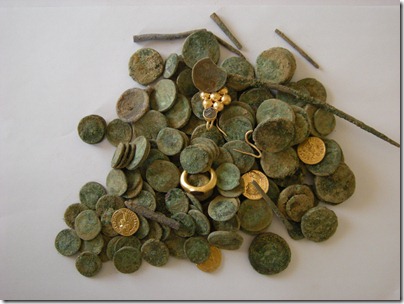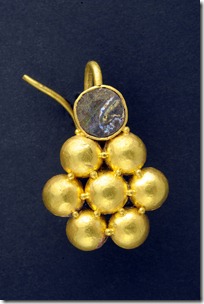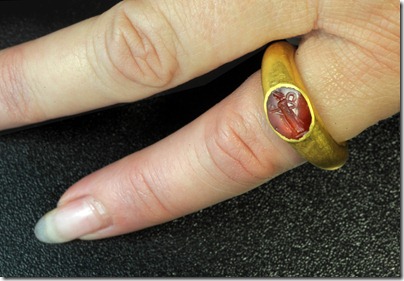A woman apparently hid her jewelry and coins in advance of the Bar Kochba Revolt (AD 132-135) and never returned to claim them. Archaeologists announced today the discovery of a hoard of 140 gold and silver coins along with some beautiful pieces of jewelry. The objects were discovered in a salvage excavation near Qiryat Gat, 5 miles (8 km) northwest of Lachish and 13 miles (20 km) east of Ashkelon. The Israel Antiquities Authority has issued a press release:
A rich and extraordinary hoard that includes jewelry and silver and gold coins from the Roman period was recently exposed in a salvage excavation in the vicinity of Qiryat Gat….
The rooms of a building dating to the Roman and Byzantine period were exposed during the course of the excavation. A pit that was dug in the earth and refilled was discerned in the building’s courtyard. To the archaeologist’s surprise, a spectacular treasure trove of exquisite quality was discovered in the pit wrapped in a cloth fabric, of which only several pieces remained on the artifacts.
According to archaeologist, Emil Aladjem, the excavation director on behalf of the Israel Antiquities Authority, “The magnificent hoard includes gold jewelry, among them an earring crafted by a jeweler in the shape of a flower and a ring with a precious stone on which there is a seal of a winged-goddess, two sticks of silver that were probably kohl sticks, as well as some 140 gold and silver coins. The coins that were discovered date to the reigns of the Roman emperors Nero, Nerva and Trajan who ruled the Roman Empire from 54-117 CE. The coins are adorned with the images of the emperors and on their reverse are cultic portrayals of the emperor, symbols of the brotherhood of warriors and mythological gods such as Jupiter seated on a throne or Jupiter grasping a lightning bolt in his hand”.
Saʽar Ganor, District Archaeologist of Ashkelon and the Western Negev for the Israel Antiquities Authority, adds “the composition of the numismatic artifacts and their quality are consistent with treasure troves that were previously attributed to the time of the Bar Kokhba Revolt. During the uprising, between 132-135 CE, the Jews under Roman rule would re-strike coins of the emperor Trajan with symbols of the revolt. This hoard includes silver and gold coins of different denominations, most of which date to the reign of the emperor Trajan. This is probably an emergency cache that was concealed at the time of impending danger by a wealthy woman who wrapped her jewelry and money in a cloth and hid them deep in the ground prior to or during the Bar Kokhba Revolt. It is now clear that the owner of the hoard never returned to claim it.


